Reliability Evaluation of the Data Acquisition Potential of a Low-Cost Climatic Network for Applications in Agriculture
Abstract
:1. Introduction
2. Materials and Methods
2.1. Meteorological Sensor Networks
2.1.1. Low-Cost Sensor Network: SEnviro Network
- Temperature. Units: Centigrade; Range: (−10, 85); Accuracy: ±0.4 degrees (C)
- Humidity. Units: Percentage; Range: (0%, 80%); Accuracy: ±3 RH
- Barometric Pressure. Units: Hectopascal; Range: (500, 1100); Accuracy: ±0.04 hPa
- Soil Moisture. Units: Percentage; Range: (0%, 85%); Accuracy: ±0.5 RH
- Wind speed. Units: km/h; Range: N/A; Accuracy: N/A
- Wind direction. Units: Direction (degrees); Range: (0) North, (1) NE, (2) East, (3) SE, (4) South, (5) SW, (6) West, (7) NW and (−1) error; Accuracy: N/A
- Rain meter. Units: millilitres (mm); Range: N/A; Accuracy: N/A
2.1.2. Official and Professional Networks: AEMET and AVAMET
AEMET
AVAMET
2.1.3. Data Preparation
2.2. Methods
3. Results and Discussion
3.1. Exploratory Analysis
3.1.1. General Range and Distribution
3.1.2. Correlograms, Dendrograms and Cluster Groupings
3.2. Standard Normal Homogeneity Test
3.3. Adjusted Series and Applied Corrections
3.4. Normalised Anomalies
3.5. Station Quality/Singularity
3.6. Similarity Analysis
4. Conclusions
Author Contributions
Funding
Acknowledgments
Conflicts of Interest
Appendix A
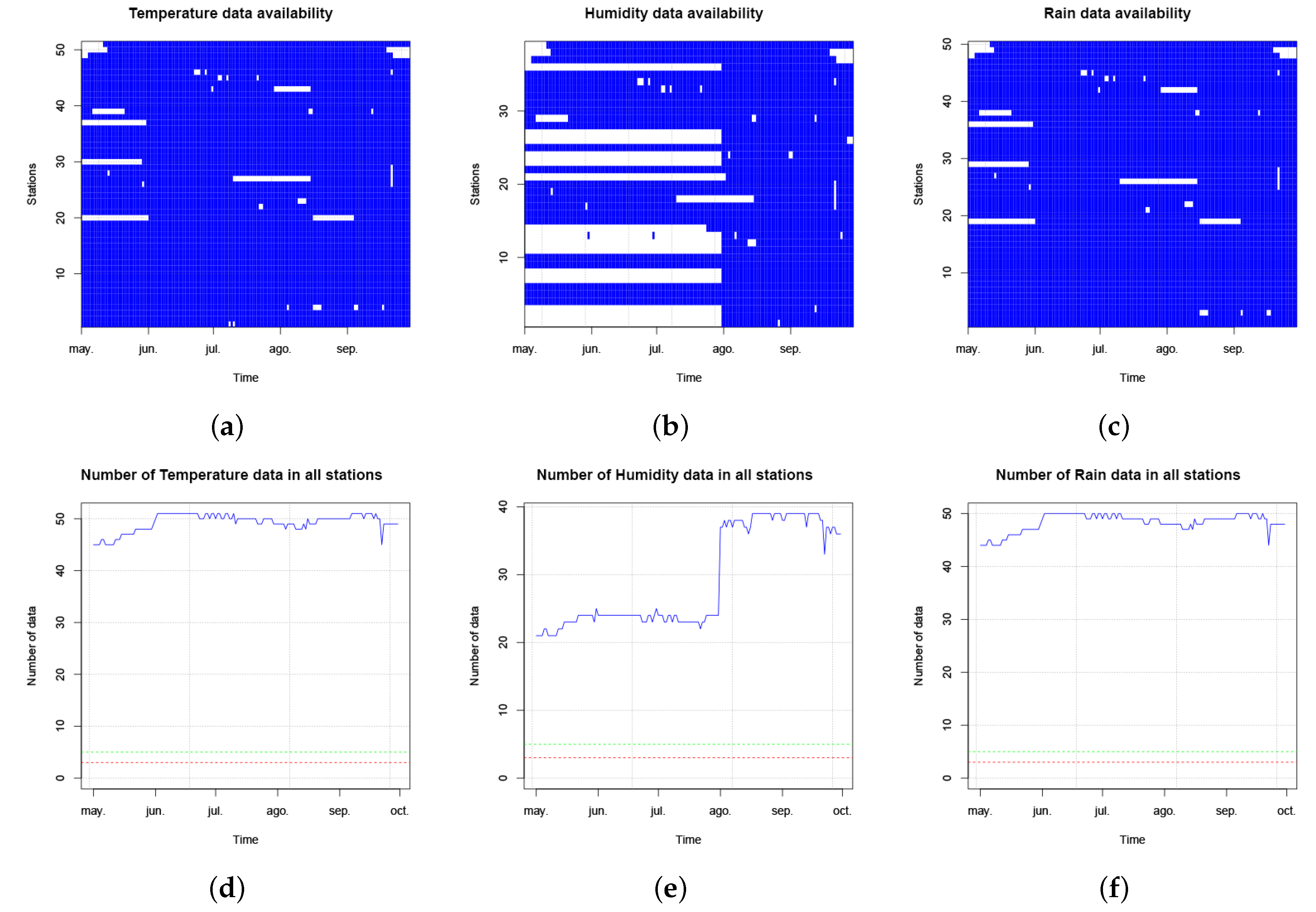
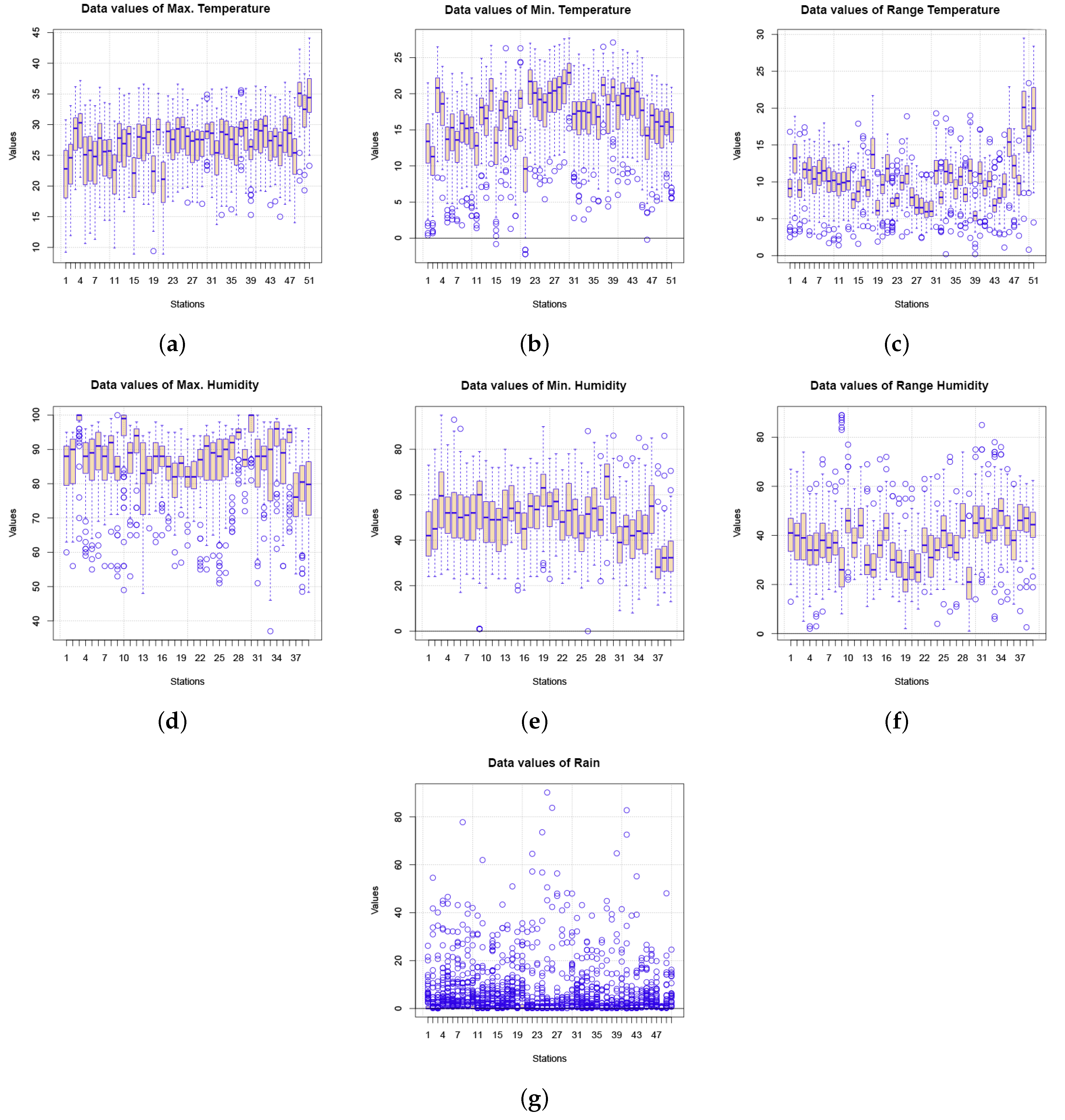
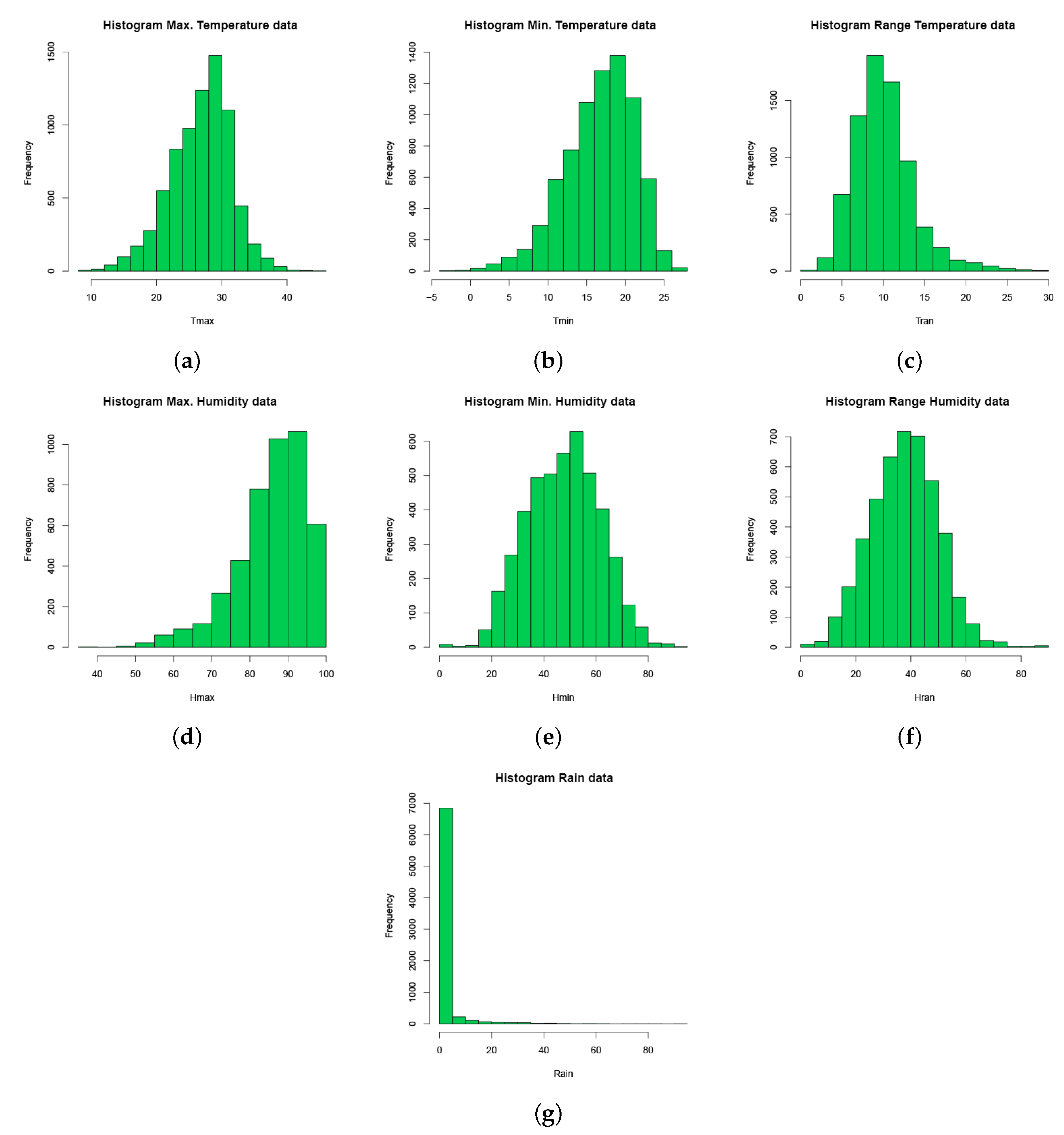
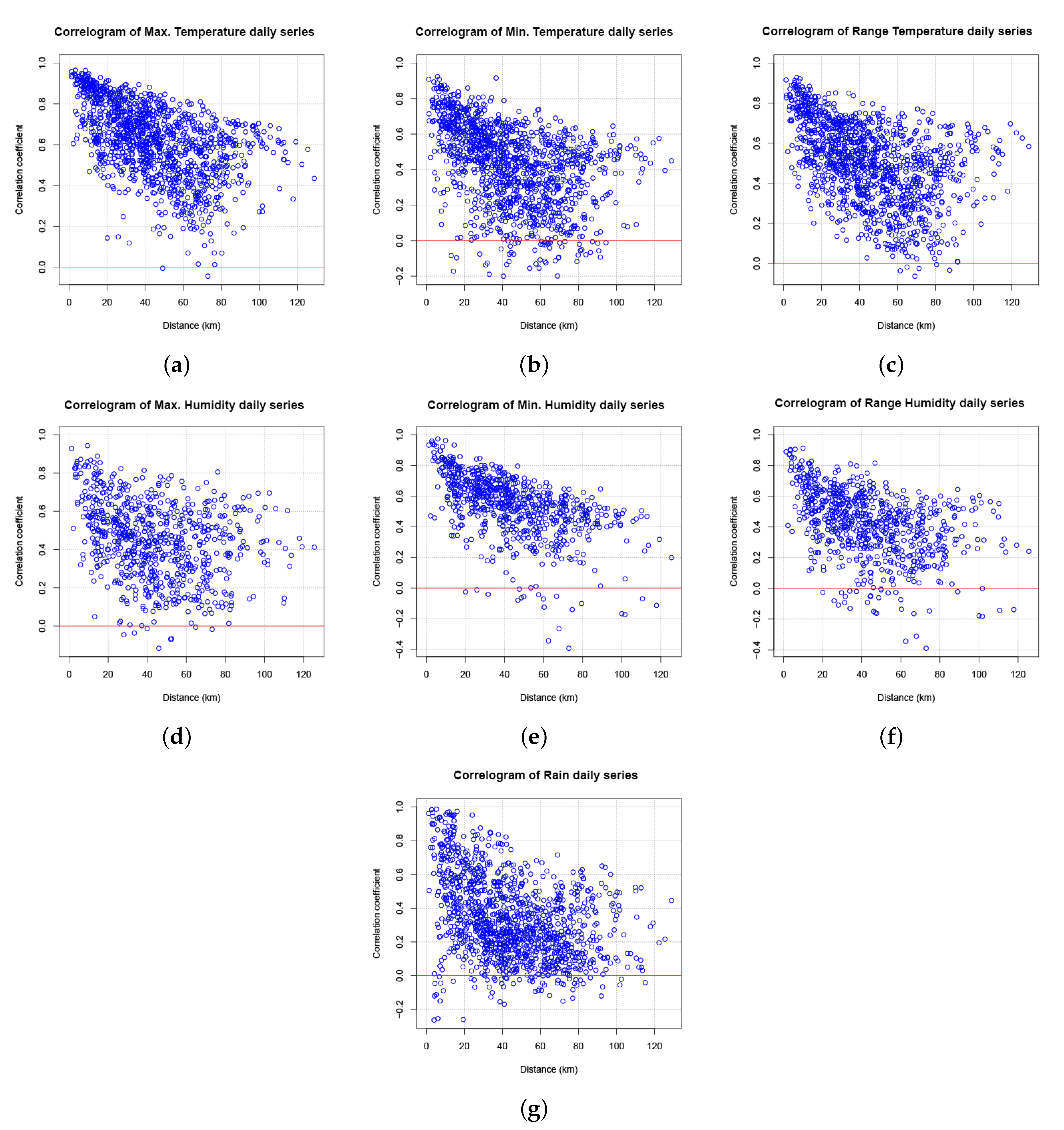
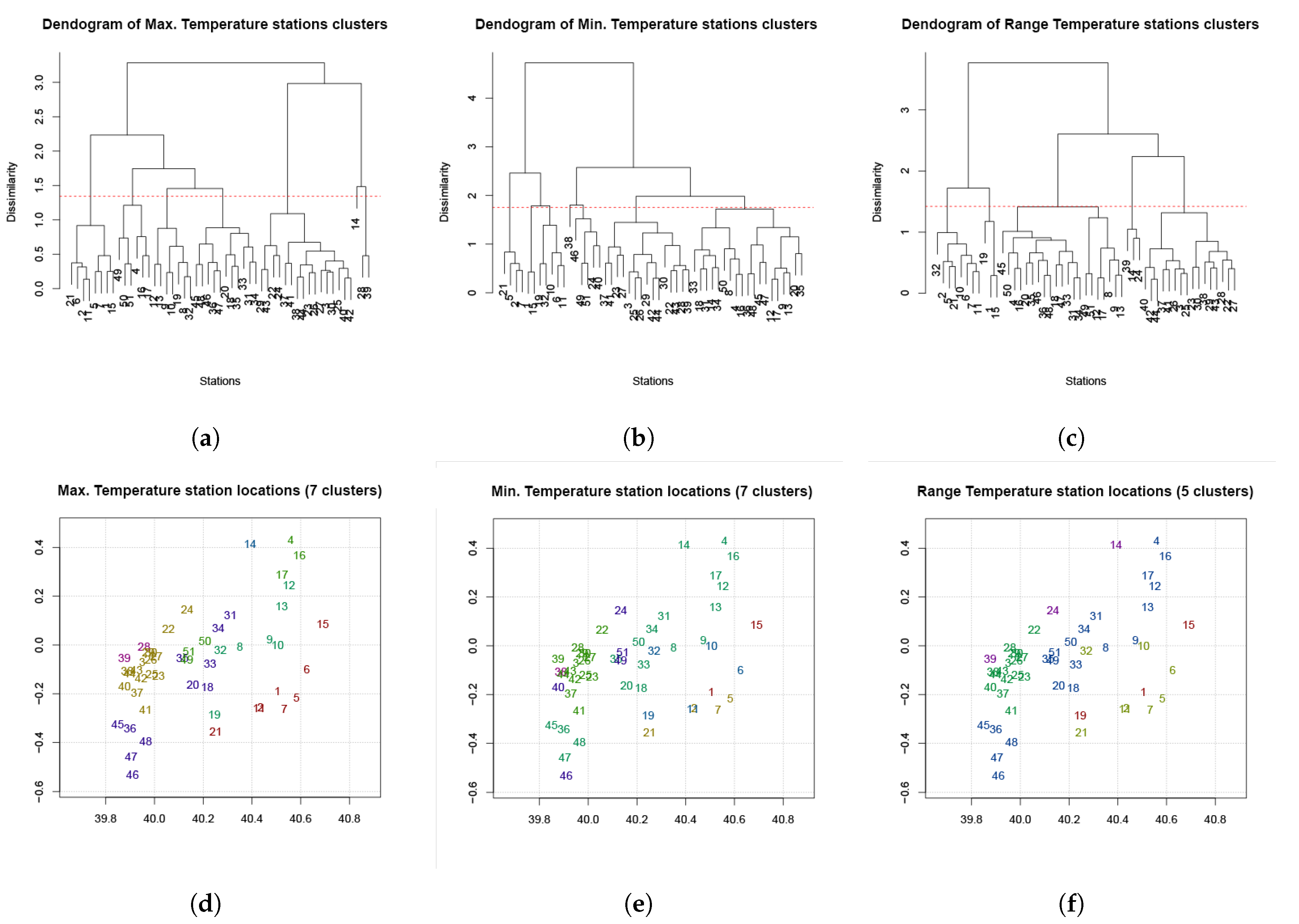
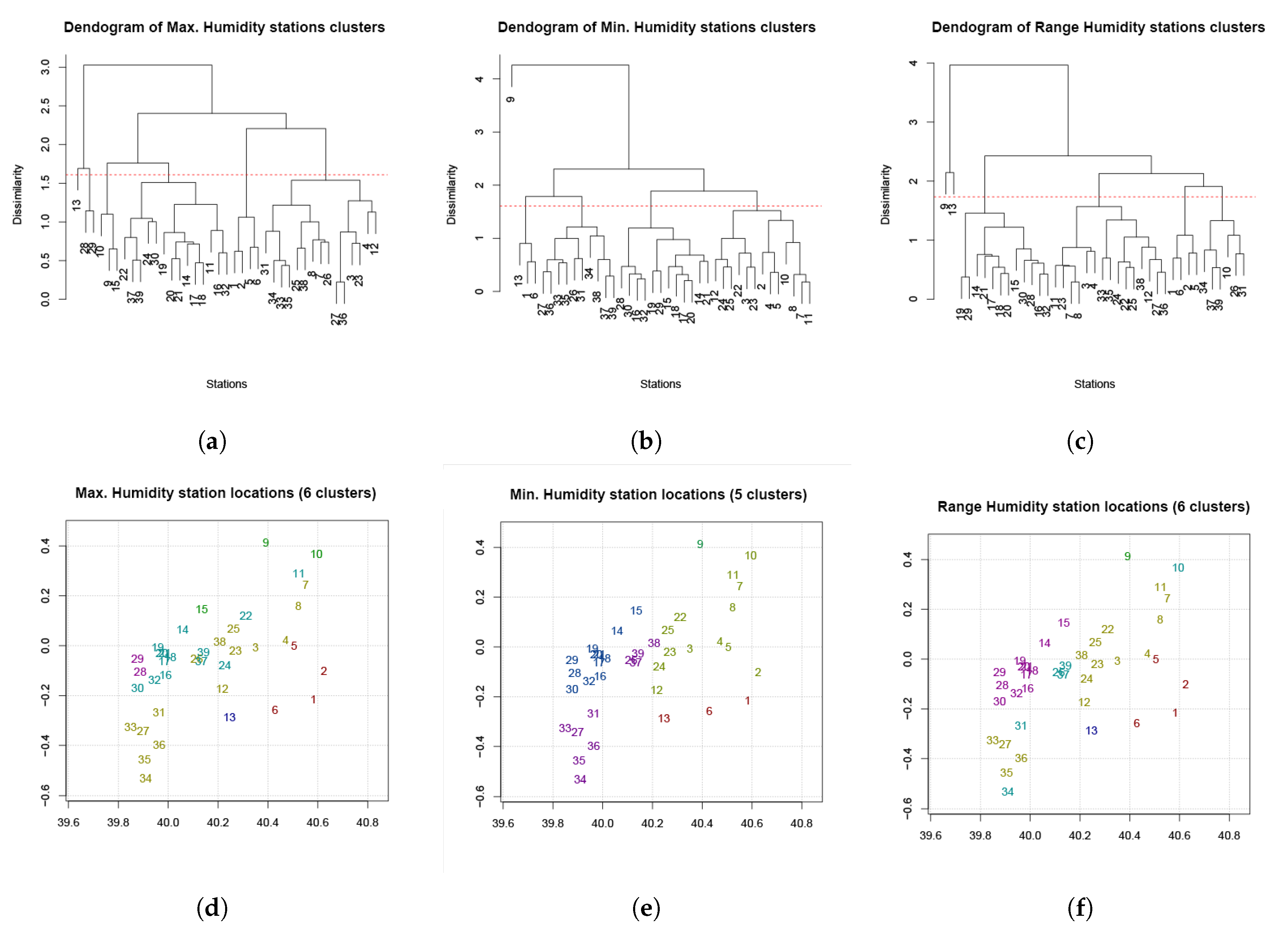
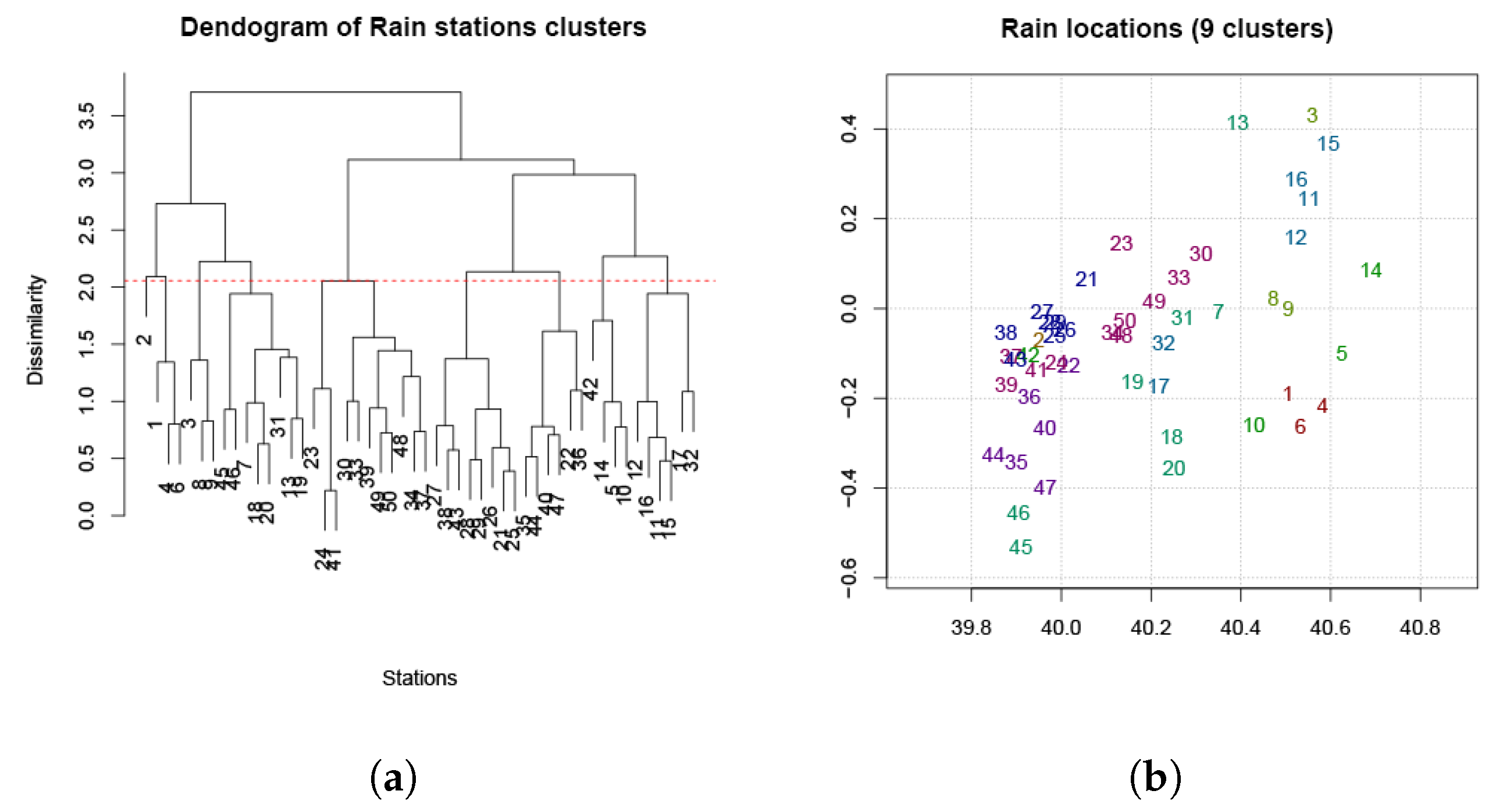
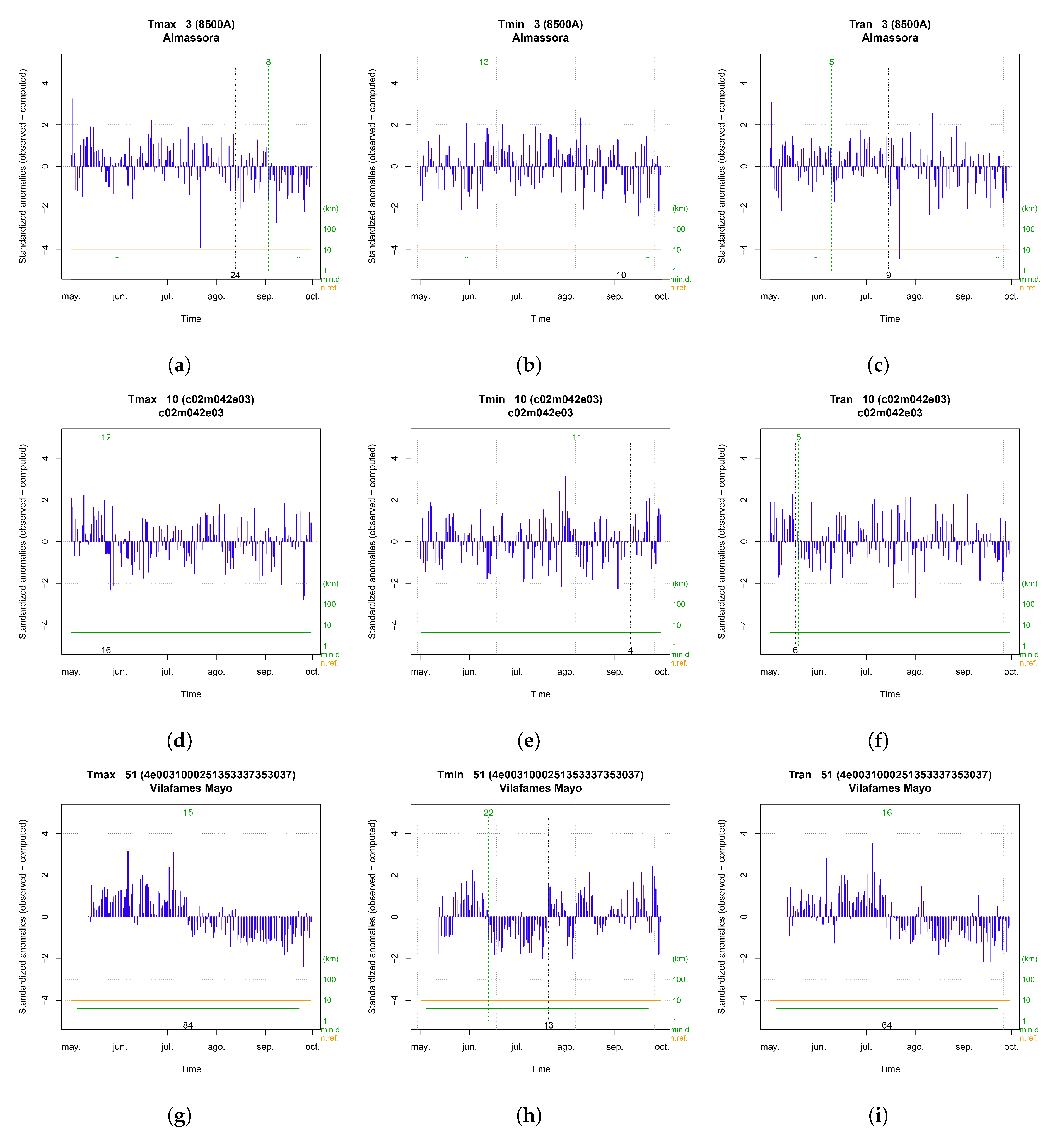
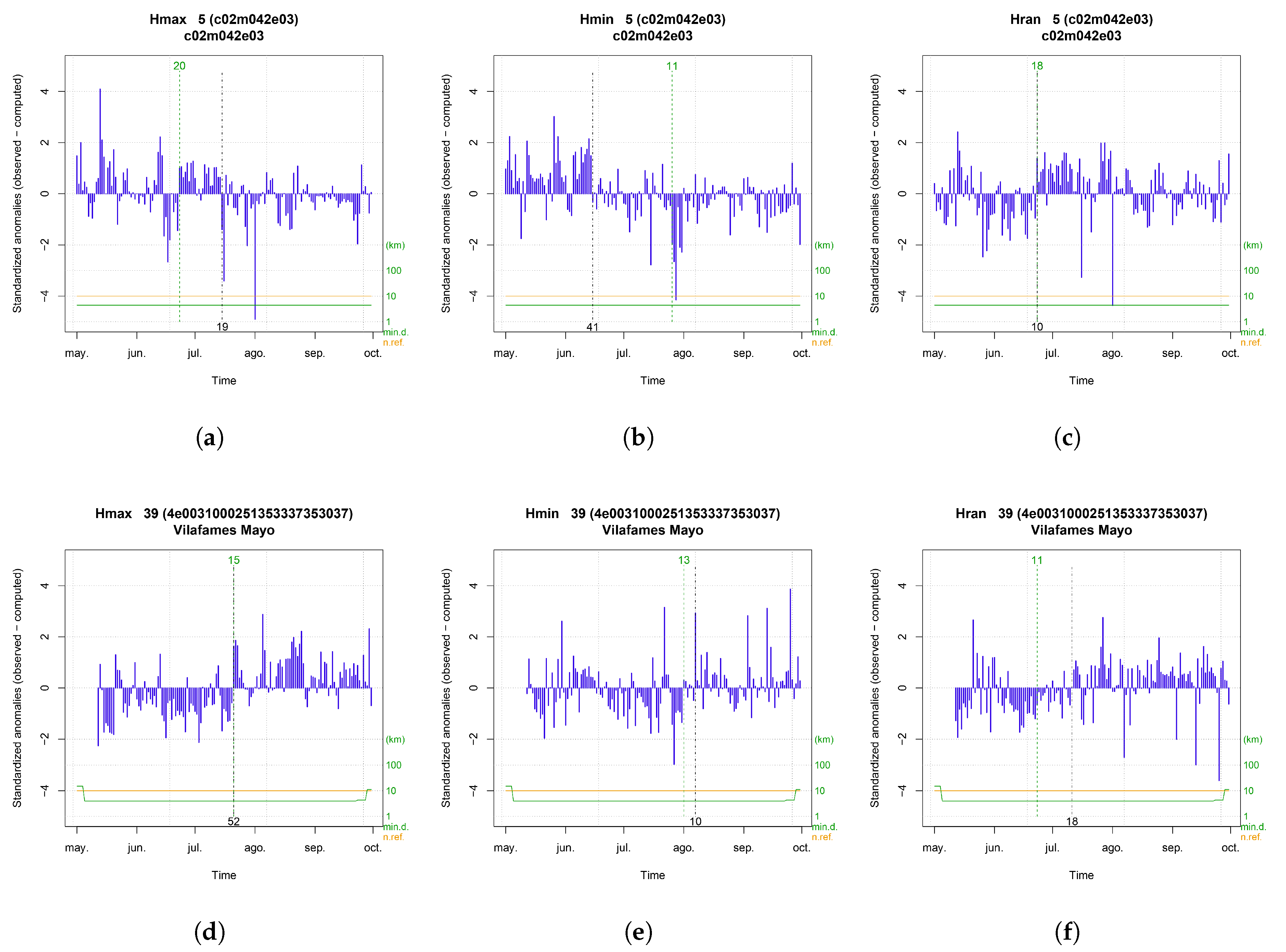
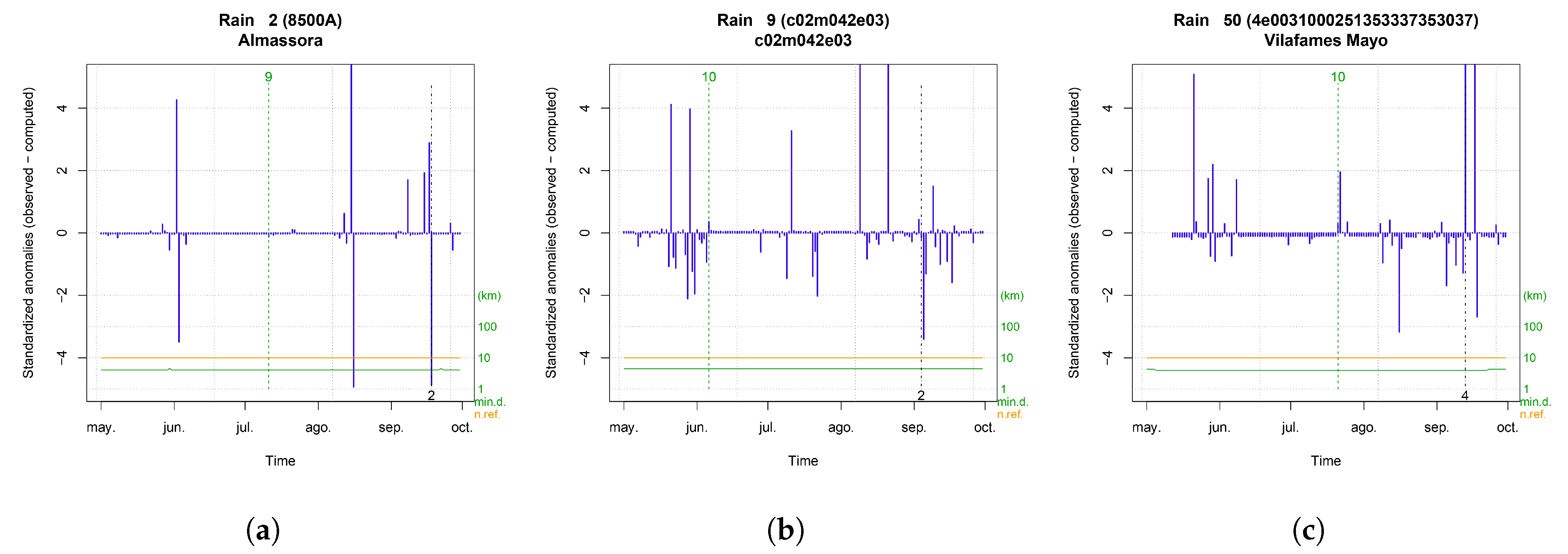

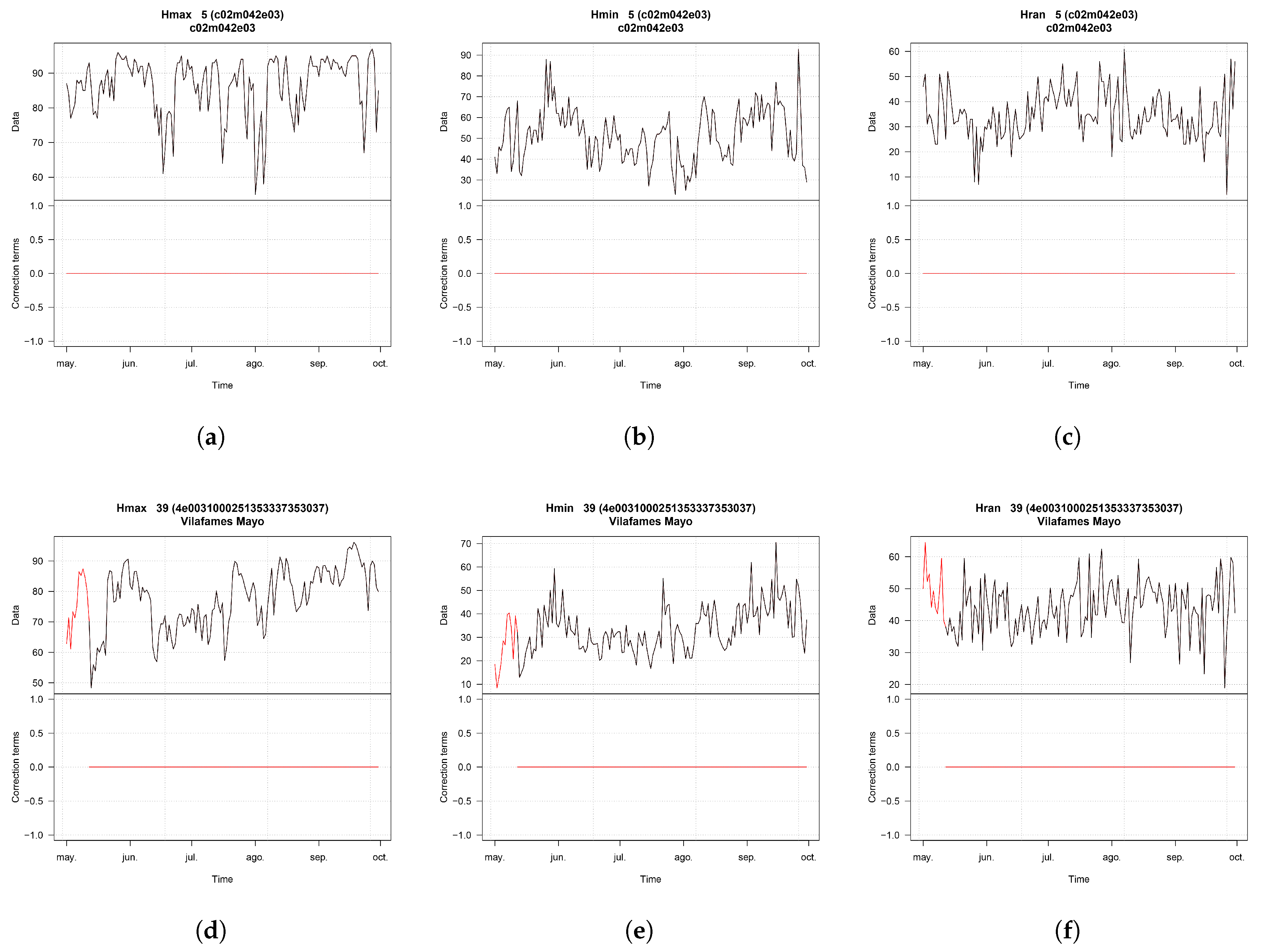

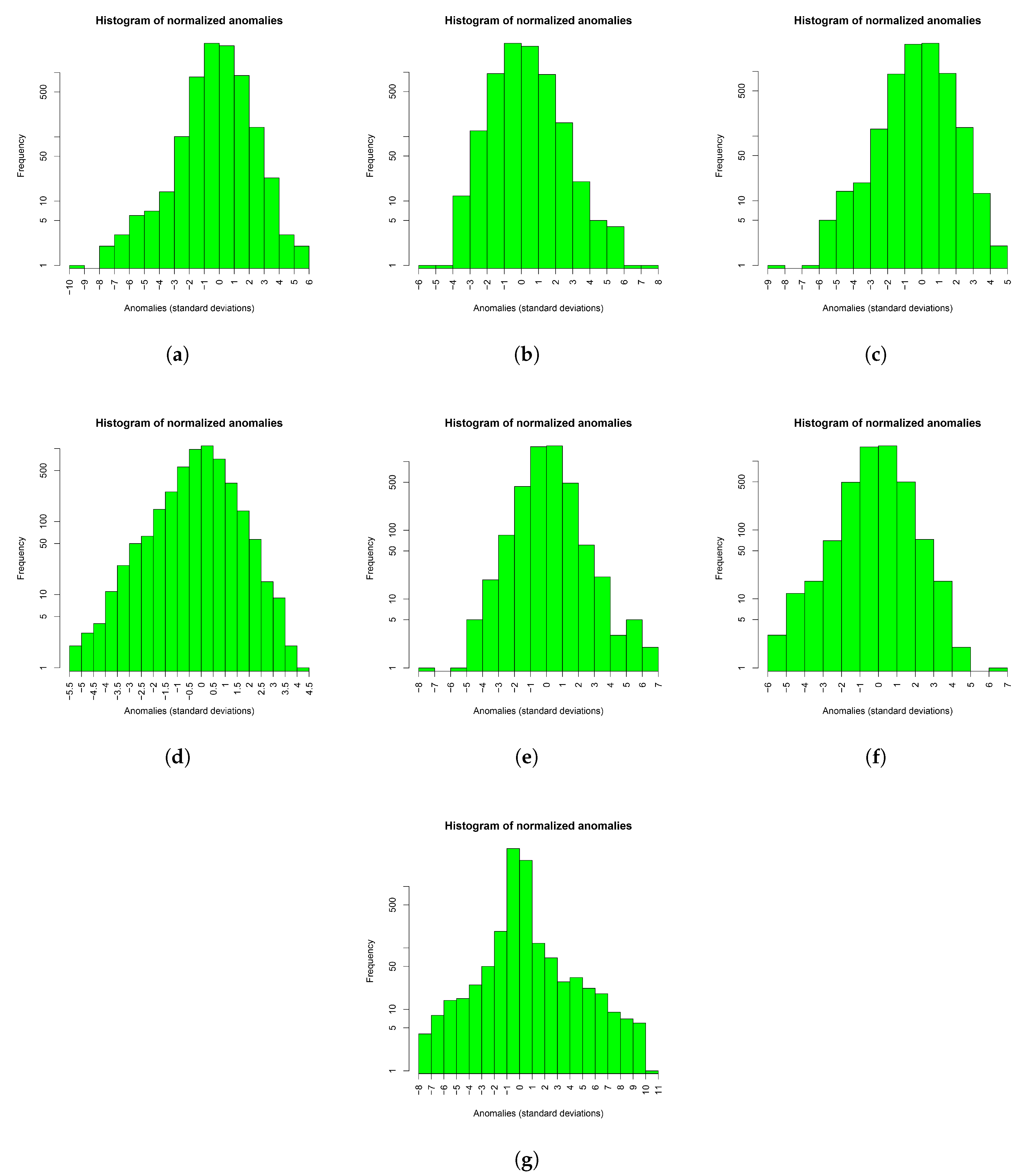
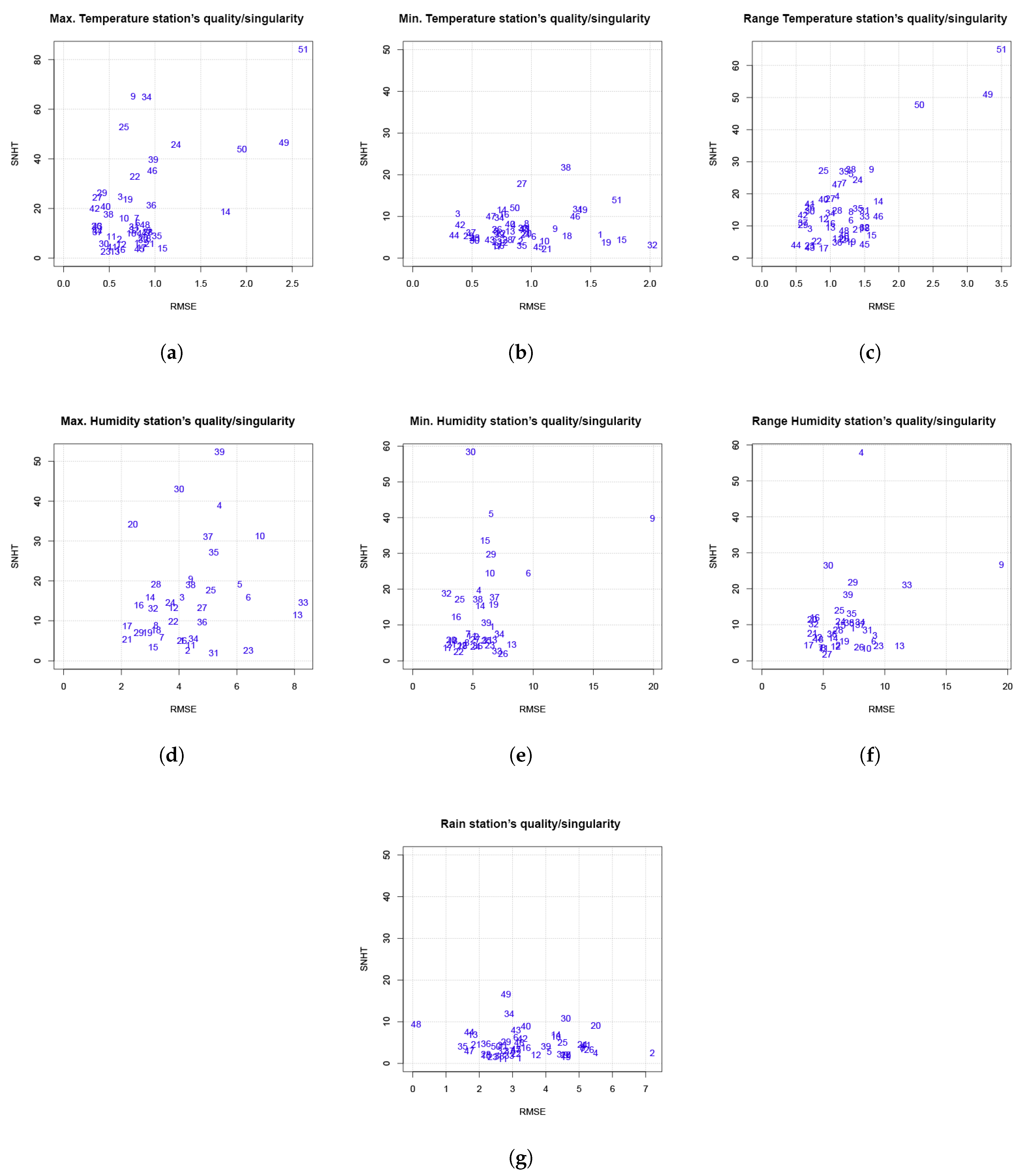
References
- Zheng, Y.; Alapaty, K.; Herwehe, J.A.; Del Genio, A.D.; Niyogi, D. Improving high-resolution weather forecasts using the Weather Research and Forecasting (WRF) Model with an updated Kain–Fritsch scheme. Mon. Weather Rev. 2016, 144, 833–860. [Google Scholar] [CrossRef]
- Trilles Oliver, S.; González-Pérez, A.; Huerta Guijarro, J. Adapting Models to Warn Fungal Diseases in Vineyards Using In-Field Internet of Things (IoT) Nodes. Sustainability 2019, 11, 416. [Google Scholar] [CrossRef] [Green Version]
- Kallos, G.; Kassomenos, P.; Pielke, R.A. Synoptic and mesoscale weather conditions during air pollution episodes in Athens, Greece. In Transport and Diffusion in Turbulent Fields; Springer: Berlin/Heidelberg, Germany, 1993; pp. 163–184. [Google Scholar]
- Cools, M.; Moons, E.; Wets, G. Assessing the impact of weather on traffic intensity. Weather Clim. Soc. 2010, 2, 60–68. [Google Scholar] [CrossRef] [Green Version]
- Trnka, M.; Rötter, R.P.; Ruiz-Ramos, M.; Kersebaum, K.C.; Olesen, J.E.; Žalud, Z.; Semenov, M.A. Adverse weather conditions for European wheat production will become more frequent with climate change. Nat. Clim. Chang. 2014, 4, 637–643. [Google Scholar] [CrossRef]
- Akasaka, H.; Nimiya, H.; Soga, K.; Matsumoto, S.I. Development of expanded AMeDAS weather data for building energy calculation in Japan/Discussion. ASHRAE Trans. 2000, 106, 455. [Google Scholar]
- Palomares Calderón de la Barca, M. Breve Historia de la Agencia Estatal de Meteorología AEMET: El Servicio Meteorológico Español; AEMET: Madrid, Spain, 2015. [Google Scholar]
- Akkaya, K.; Younis, M. A survey on routing protocols for wireless sensor networks. Ad Hoc Netw. 2005, 3, 325–349. [Google Scholar] [CrossRef] [Green Version]
- Akyildiz, I.F.; Su, W.; Sankarasubramaniam, Y.; Cayirci, E. Wireless sensor networks: A survey. Comput. Netw. 2002, 38, 393–422. [Google Scholar] [CrossRef] [Green Version]
- Trilles, S.; Luján, A.; Belmonte, Ó.; Montoliu, R.; Torres-Sospedra, J.; Huerta, J. SEnviro: A sensorized platform proposal using open hardware and open standards. Sensors 2015, 15, 5555–5582. [Google Scholar] [CrossRef] [Green Version]
- Granell, C.; Kamilaris, A.; Kotsev, A.; Ostermann, F.O.; Trilles, S. Internet of Things. In Manual of Digital Earth; Springer: Berlin/Heidelberg, Germany, 2020; pp. 387–423. [Google Scholar]
- Ojha, T.; Misra, S.; Raghuwanshi, N.S. Wireless sensor networks for agriculture: The state-of-the-art in practice and future challenges. Comput. Electron. Agric. 2015, 118, 66–84. [Google Scholar] [CrossRef]
- Pérez-Expósito, J.P.; Fernández-Caramés, T.M.; Fraga-Lamas, P.; Castedo, L. An IoT monitoring system for precision viticulture. In Proceedings of the 2017 IEEE International Conference on Internet of Things (iThings) and IEEE Green Computing and Communications (GreenCom) and IEEE Cyber, Physical and Social Computing (CPSCom) and IEEE Smart Data (SmartData), Exeter, UK, 21–23 June 2017; pp. 662–669. [Google Scholar]
- Delp, C.J. Effect of temperature and humidity on the grape powdery mildew fungus. Phytopathology 1954, 44, 615–626. [Google Scholar]
- Francesca, S.; Simona, G.; Francesco Nicola, T.; Andrea, R.; Vittorio, R.; Federico, S.; Cynthia, R.; Maria Lodovica, G. Downy mildew (Plasmopara viticola) epidemics on grapevine under climate change. Glob. Chang. Biol. 2006, 12, 1299–1307. [Google Scholar] [CrossRef]
- Wolfert, S.; Ge, L.; Verdouw, C.; Bogaardt, M.J. Big data in smart farming—A review. Agric. Syst. 2017, 153, 69–80. [Google Scholar] [CrossRef]
- Trilles, S.; Torres-Sospedra, J.; Belmonte, Ó.; Zarazaga-Soria, F.J.; González-Pérez, A.; Huerta, J. Development of an open sensorized platform in a smart agriculture context: A vineyard support system for monitoring mildew disease. Sustain. Comput. Inform. Syst. 2019, 2019, 100309. [Google Scholar] [CrossRef]
- Thorat, S.K. An Effective Early Identification of Diseases causes Parameter and Decision Making System based on Agriculture IoT. Int. J. Innov. Sci. Res. Technol. 2018, 3, 560–565. [Google Scholar]
- Bischoff, V.; Farias, K. VitForecast: An IoT approach to predict diseases in vineyard. In Proceedings of the XVI Brazilian Symposium on Information Systems, São Bernardo do Campo, Brazil, 3–6 November 2020; Association for Computing Machinery: New York, NY, USA, 2020; pp. 1–8. [Google Scholar]
- SmartVineyard|SmartVineyard Precision Viticulture System to Monitor Grape Diseases. Available online: http://smartvineyard.com/smartvineyard-precision-viticulture/ (accessed on 2 June 2020).
- Trilles, S.; González-Pérez, A.; Huerta, J. A Comprehensive IoT Node Proposal Using Open Hardware. A Smart Farming Use Case to Monitor Vineyards. Electronics 2018, 7, 419. [Google Scholar] [CrossRef] [Green Version]
- Trilles, S.; González-Pérez, A.; Huerta, J. An IoT Platform Based on Microservices and Serverless Paradigms for Smart Farming Purposes. Sensors 2020, 20, 2418. [Google Scholar] [CrossRef]
- Trilles, S.; Vicente, A.B.; Juan, P.; Ramos, F.; Meseguer, S.; Serra, L. Reliability Validation of a Low-Cost Particulate Matter IoT Sensor in Indoor and Outdoor Environments Using a Reference Sampler. Sustainability 2019, 11, 7220. [Google Scholar] [CrossRef] [Green Version]
- Lindau, R.; Venema, V. Random trend errors in climate station data due to inhomogeneities. Int. J. Climatol. 2019, 40. [Google Scholar] [CrossRef] [Green Version]
- Aguilar, E.; Auer, I.; Brunet, M.; Peterson, T.; Wieringa, J. Guidelines on Climate Metadata and Homogenization; World Climate Programme Data and Monitoring WCDMP-No. 53, WMO-TD No. 1186; World Meteorological Organization: Geneva, Switzerland, 2003; Volume 55. [Google Scholar]
- Peterson, T.C.; Easterling, D.R.; Karl, T.R.; Groisman, P.; Nicholls, N.; Plummer, N.; Torok, S.; Auer, I.; Boehm, R.; Gullett, D.; et al. Homogeneity adjustments of in situ atmospheric climate data: A review. Int. J. Climatol. 1998, 18, 1493–1517. [Google Scholar] [CrossRef]
- Guijarro, J.A. User’s Guide to Climatol; An R Contributed Package for Homogenization of Climatological Series; State Meteorological Agency (AEMET); Balearic Islands Office: Palma de Mallorca, Spain, 2011.
- Derrick, T.R.; Thomas, J.M. Time series analysis: The cross-correlation function. In Innovative Analyses of Human Movement; Iowa State University Digital Repository, Stergiou, N., Eds.; Human Kinetics Publishers: Champaign, IL, USA, 2004; pp. 189–205. [Google Scholar]
- Sala, J.Q.; Chiva, E.M.; Vázquez, M.V.Q. La elevación de las temperaturas en el norte de la Comunidad Valenciana: Valor y naturaleza (1950–2016). In Investigaciones Geográficas; Biblioteca Virtual Miguel de Cervantes: Alicante, Spain, 2018; pp. 41–53. [Google Scholar]
- González Herrero, S.; Bech, J. Extreme point rainfall temporal scaling: A long term (1805–2014) regional and seasonal analysis in Spain: Extreme point rainfall temporal scaling in Spain. Int. J. Climatol. 2017, 37, 5068–5079. [Google Scholar] [CrossRef] [Green Version]
- Trilles, S.; González-Pérez, A.; Zaragozí, B.; Huerta, J. Data on records of environmental phenomena using low-cost sensors in vineyard smallholdings. Data Brief 2020, 2020, 106524. [Google Scholar] [CrossRef]
- Conrad, V. Methods in Climatology; Read Books; Harvard University Press: Cambridge, UK, 2007; p. 212. [Google Scholar]
- Alexandersson, H. A homogeneity test applied to precipitation data. J. Climatol. 1986, 6, 661–675. [Google Scholar] [CrossRef]
- Aguilar, E.; López, J.; Brunet, M.; Saladié, Ó.; Sigró, J.; López, D. Control de Calidad y Proceso de Homogeneización de Series térmicas Catalanas; Raso, J.M., Martín-Vide, J., Eds.; La Climatología Española los Albores del Siglo XXI; Oikos-Tau y Asociación Española de Climatología: Barcelona, Spain, 1999; pp. 15–23. [Google Scholar]
- Cryer, J.D.; Chan, K.S. Time Series Analysis: With Applications in R; Springer Science & Business Media: Berlin/Heidelberg, Germany, 2008. [Google Scholar]
- Metcalfe, A.V.; Cowpertwait, P.S. Introductory Time Series with R; Springer: Berlin/Heidelberg, Germany, 2009. [Google Scholar]
- Cressie, N. Statistics for Spatial Data; John Wiley and Sons: New York, NY, USA, 1993. [Google Scholar]
- Yamamoto, K.; Togami, T.; Yamaguchi, N.; Ninomiya, S. Machine learning-based calibration of low-cost air temperature sensors using environmental data. Sensors 2017, 17, 1290. [Google Scholar] [CrossRef] [PubMed] [Green Version]
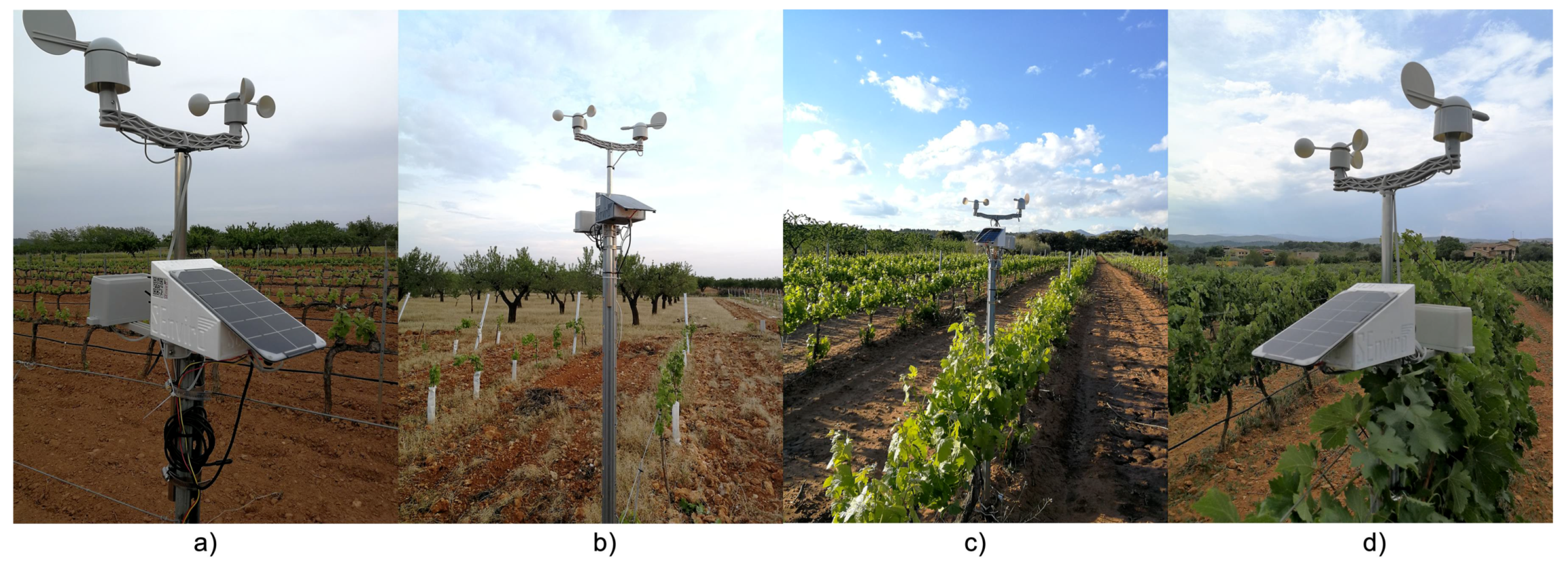
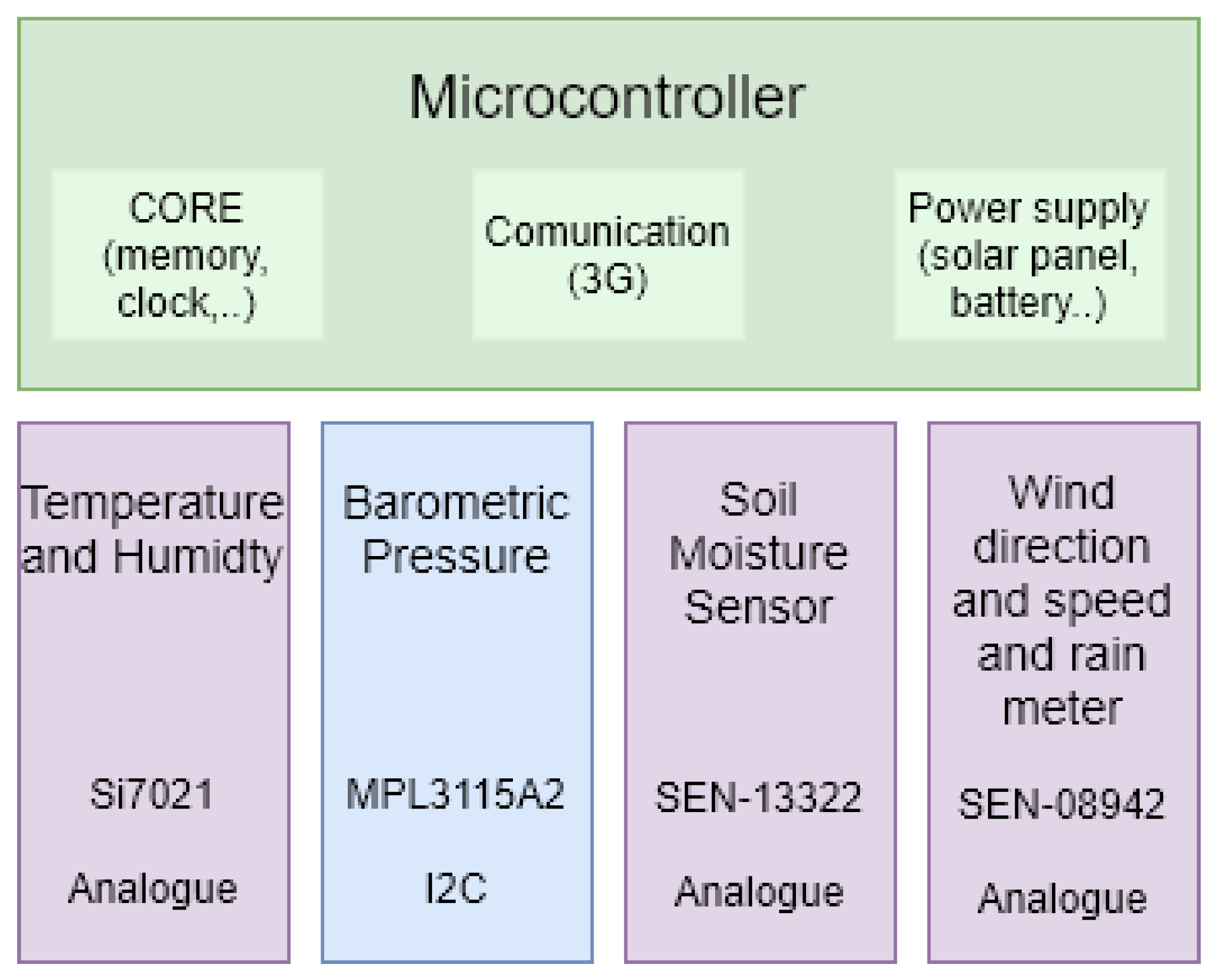
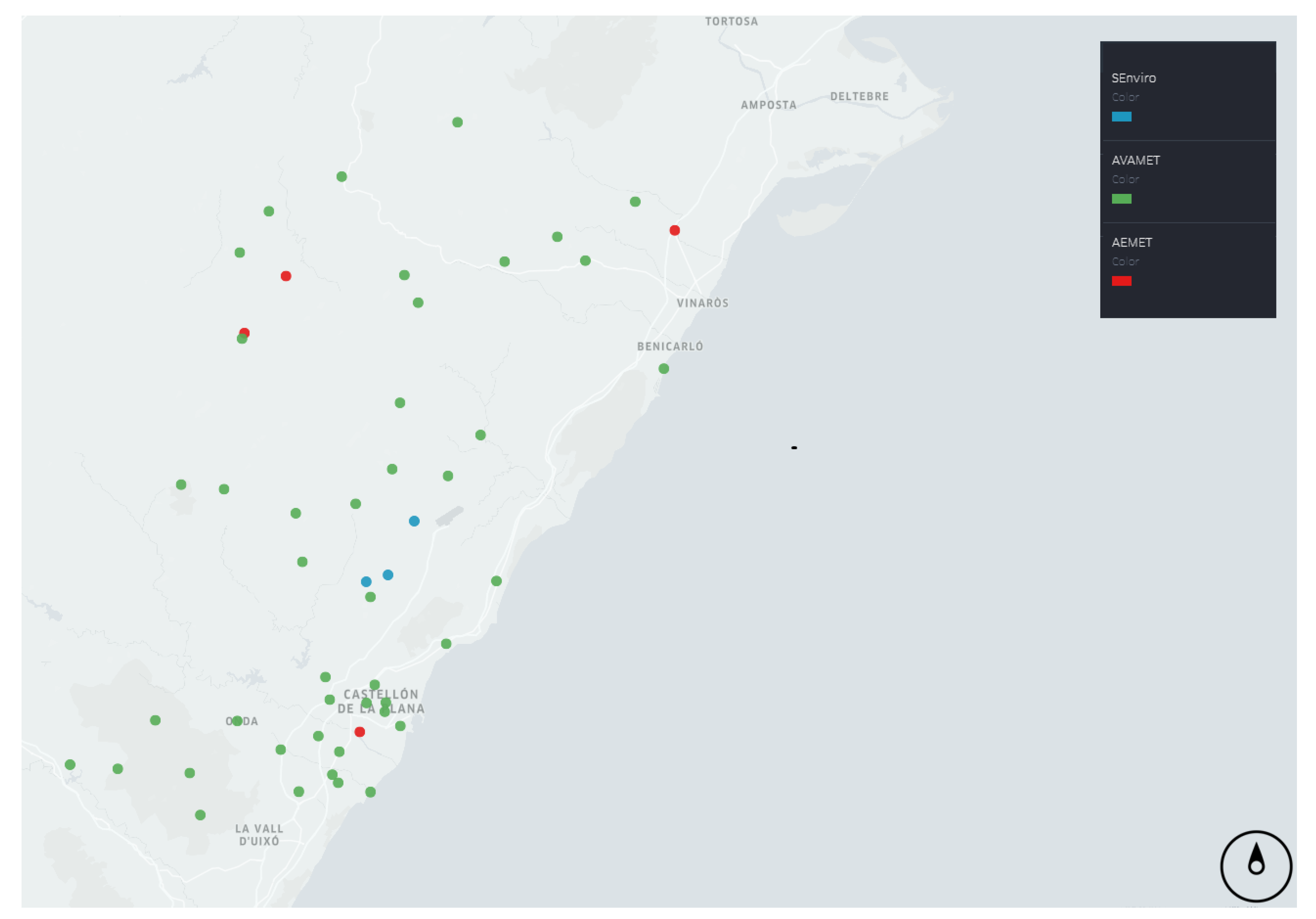
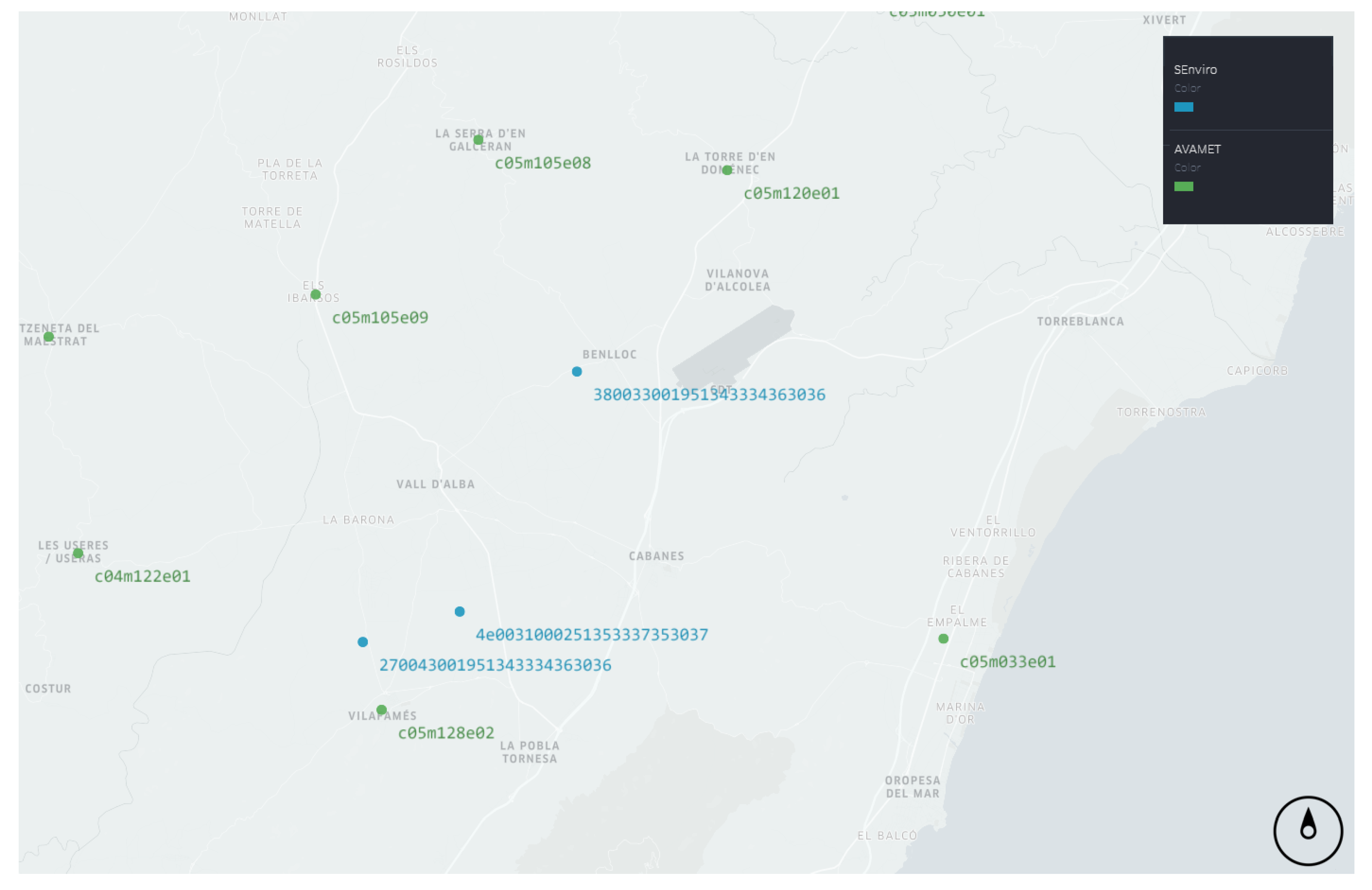
| Sensor Num. | Location (lat, long) | Area (metres) | Vine Variety |
|---|---|---|---|
| 270…363036 (SEnviro1) | 40.133098, −0.061000 | 20,000 | Monastrell |
| 4e0…353037 (SEnviro2) | 40.206870, 0.015536 | 18,000 | Merlot, cabernet, chardonnay and syrah |
| 380…363036 (SEnviro3) | 40.141384, −0.026397 | 15,000 | Bonicaire |
| Phenomena | SEnviro | SEnviro1 | SEnviro2 | SEnviro3 | |
|---|---|---|---|---|---|
| AVAMET | |||||
| c04m122e01 | 0.27 | 0.27 | 0.00 | ||
| c05m128e02 | 0.54 | 0.61 | 0.72 | ||
| Maximum | c05m105e09 | 0.47 | 0.53 | 0.45 | |
| c05m105e08 | 0.30 | 0.30 | 0.47 | ||
| c05m120e01 | 0.27 | 0.27 | 0.00 | ||
| c04m122e01 | 0.73 | 0.92 | 1.00 | ||
| c05m128e02 | 0.53 | 0.48 | 0.39 | ||
| Minimum | c05m105e09 | 0.62 | 0.72 | 0.64 | |
| c05m105e08 | 0.37 | 0.42 | 0.56 | ||
| c05m120e01 | 1.00 | 0.92 | 1.00 | ||
| SEnviro | SEnviro1 | SEnviro2 | SEnviro3 | |
|---|---|---|---|---|
| AVAMET | ||||
| c04m122e01 | 0.46 | 0.200 | 0.10 | |
| c05m128e02 | 0.97 | 0.40 | −0.32 | |
| c05m105e09 | 0.18 | 0.34 | 0.09 | |
| c05m105e08 | 0.76 | −0.26 | 0.58 | |
| c05m120e01 | 0.46 | 0.02 | 0.26 | |
| Phenomena | SEnviro | SEnviro1 | SEnviro2 | SEnviro3 | |
|---|---|---|---|---|---|
| AVAMET | |||||
| c04m122e01 | 0.69 | 0.82 | 0.60 | ||
| c05m128e02 | 0.49 | 0.72 | 0.59 | ||
| Maximum | c05m105e09 | 0.52 | 0.70 | 0.63 | |
| c05m105e08 | 0.48 | 0.64 | 0.62 | ||
| c05m120e01 | 0.59 | 0.82 | 0.56 | ||
| c04m122e01 | 0.33 | 0.25 | 0.48 | ||
| c05m128e02 | 0.41 | 0.28 | 0.53 | ||
| Minimum | c05m105e09 | 0.62 | 0.47 | 0.63 | |
| c05m105e08 | −0.22 | −0.23 | 0.12 | ||
| c05m120e01 | 0.33 | 0.25 | 0.47 | ||
Publisher’s Note: MDPI stays neutral with regard to jurisdictional claims in published maps and institutional affiliations. |
© 2020 by the authors. Licensee MDPI, Basel, Switzerland. This article is an open access article distributed under the terms and conditions of the Creative Commons Attribution (CC BY) license (http://creativecommons.org/licenses/by/4.0/).
Share and Cite
Trilles, S.; Juan, P.; Díaz-Avalos, C.; Ribeiro, S.; Painho, M. Reliability Evaluation of the Data Acquisition Potential of a Low-Cost Climatic Network for Applications in Agriculture. Sensors 2020, 20, 6597. https://doi.org/10.3390/s20226597
Trilles S, Juan P, Díaz-Avalos C, Ribeiro S, Painho M. Reliability Evaluation of the Data Acquisition Potential of a Low-Cost Climatic Network for Applications in Agriculture. Sensors. 2020; 20(22):6597. https://doi.org/10.3390/s20226597
Chicago/Turabian StyleTrilles, Sergio, Pablo Juan, Carlos Díaz-Avalos, Sara Ribeiro, and Marco Painho. 2020. "Reliability Evaluation of the Data Acquisition Potential of a Low-Cost Climatic Network for Applications in Agriculture" Sensors 20, no. 22: 6597. https://doi.org/10.3390/s20226597
APA StyleTrilles, S., Juan, P., Díaz-Avalos, C., Ribeiro, S., & Painho, M. (2020). Reliability Evaluation of the Data Acquisition Potential of a Low-Cost Climatic Network for Applications in Agriculture. Sensors, 20(22), 6597. https://doi.org/10.3390/s20226597







